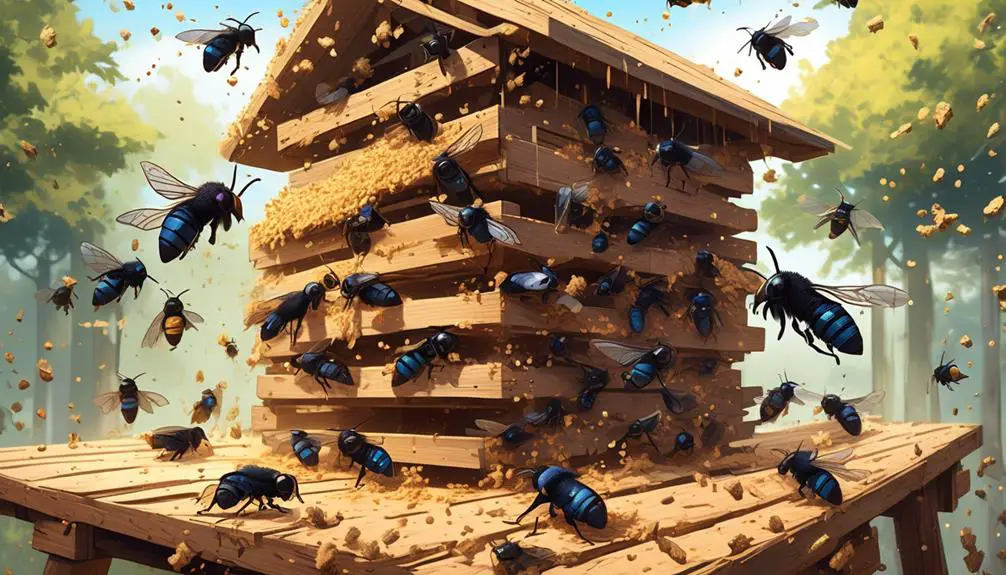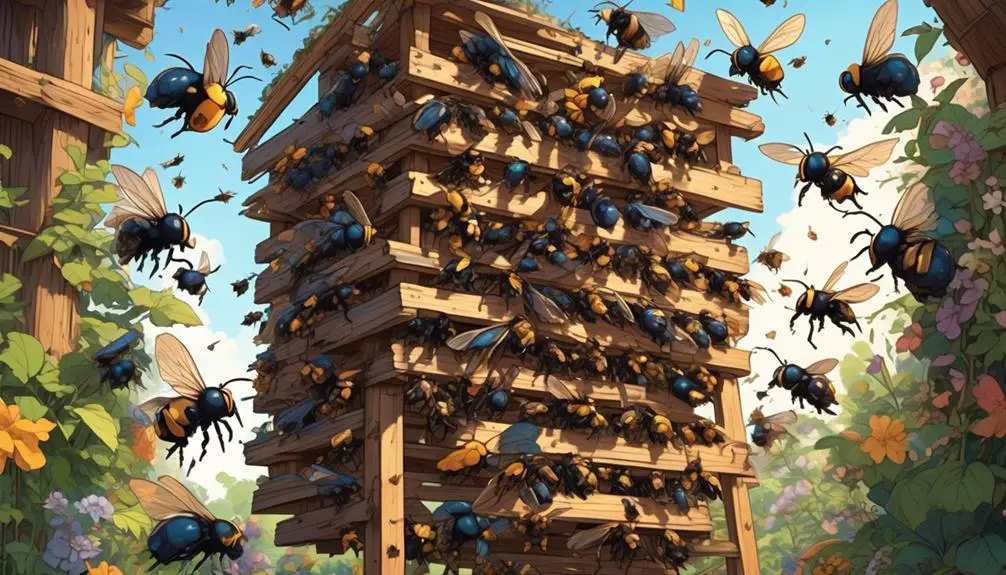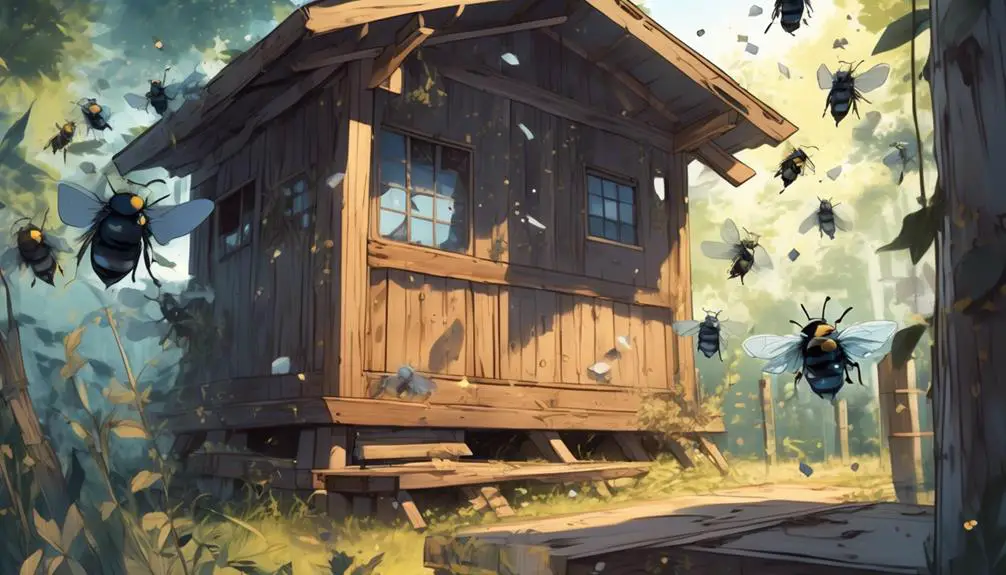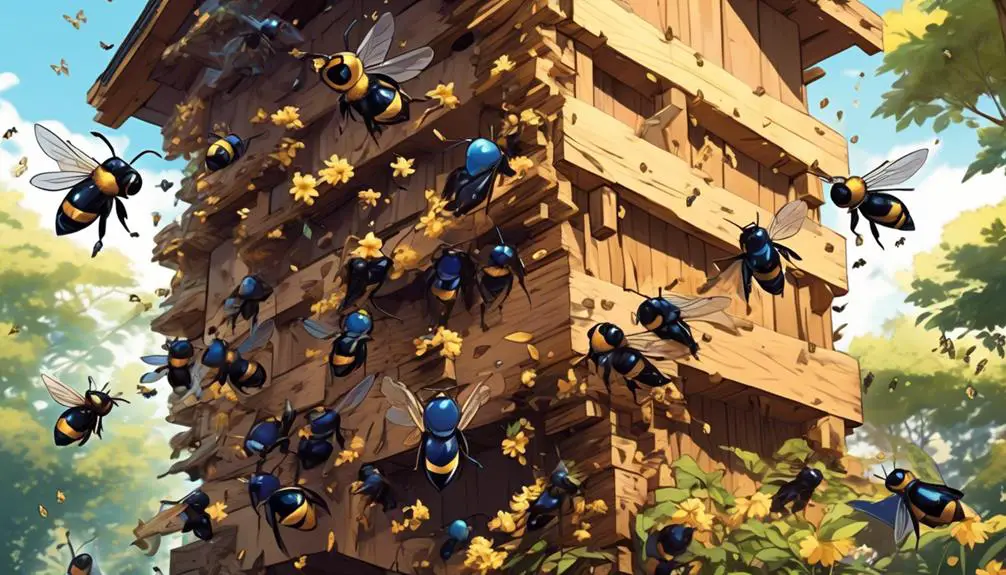Yearning to understand if carpenter bees swarm? Dive into the solitary world of these bees and uncover the buzz-worthy truth.

Do Carpenter Bees Swarm
You've probably seen those old-timey pictures of beekeepers, surrounded by a swirling cloud of bees, and wondered, 'Can carpenter bees do that?'
As you navigate this intriguing topic, you'll find there's more to the story than meets the eye. Carpenter bees, with their solitary nature, present a different set of behaviors than their honeybee counterparts.
But what about those times when you see more than one buzzing around your garden? Could this be considered a swarm?
Let's explore the fascinating world of carpenter bees together to uncover the truth.
Key Takeaways
- Carpenter bees are solitary insects that do not form colonies or have worker bees.
- Mating season and nest construction can create swarm-like activity, but it is not true swarming behavior.
- Male carpenter bees become active during mating season, creating a flurry of activity that can be mistaken for a swarm.
- Female carpenter bees flying repeatedly in the same area may give the illusion of a swarm, but they are simply constructing their nests.
Understanding Carpenter Bee Behavior

To understand carpenter bee behavior, you must first recognize that these insects are solitary, with each female constructing her own nest, unlike many other bee species that exhibit social structures. These bees don't form colonies or have worker bees. Each female bee is capable of laying eggs, and they don't rely on a queen for reproduction.
Carpenter bees are notorious for their unique nesting habits. They bore into wood, creating galleries where they lay their eggs. You'll often find them in eaves, window sills, and wooden furniture. Their preference for wood isn't arbitrary, it's a survival strategy. Wood provides protection against weather and predators, ensuring the survival of their offspring.
They're also known for their aggressive defense mechanisms. Males, although harmless due to their lack of stingers, often exhibit threatening behavior to ward off predators. Females, on the other hand, can sting, but they're usually docile unless provoked.
Understanding the behavior of carpenter bees is crucial for effective pest control. Recognizing their solitary nature, unique nesting habits, and defensive behaviors can help you manage and prevent infestations. Always remember, they're more than just pests, they're important pollinators contributing to our ecosystem.
The Swarming Misconception

Despite their solitary nature, it's not uncommon to mistake the activity of carpenter bees for swarming behavior. This perception arises primarily due to a lack of understanding about their unique habits. To clarify, carpenter bees aren't social insects, unlike honey bees. They don't form colonies or follow a queen bee. They're independent, with each female maintaining her own nest.
The misconception about swarming could be attributed to the mating habits of carpenter bees. During the mating season, you might see a large number of carpenter bees flying around a particular area. This isn't a swarm, but rather males vying for the attention of available females, creating a buzz of activity.
Furthermore, carpenter bees have a tendency to reuse old nests, leading to a concentration of bees in a particular location. This can also give the false impression of a swarm. The presence of multiple bees doesn't indicate a collective social structure, but rather individual bees living parallel lives.
The Solitary Nature of Carpenter Bees

Understanding the solitary nature of carpenter bees can further dispel the swarming myth, shedding light on their individualistic lifestyle and nesting behaviors. Unlike honeybees or bumblebees, carpenter bees aren't social insects. They don't live in large colonies, nor do they swarm. Each female carpenter bee is, in fact, a solitary queen bee, carving out her nest in wood and raising her offspring without the help of a colony.
To help visualize this, consider the following table that contrasts carpenter bees with social bees:
Trait | Carpenter Bees | Social Bees |
|---|---|---|
Nesting | Solitary | Colony |
Food Gathering | Individual | Group |
Offspring Care | Individual | Group |
Your understanding of carpenter bees' solitary nature should now be clearer. They're lone workers, handling all aspects of survival and reproduction on their own. This, combined with their non-aggressive disposition unless provoked, further emphasizes why you won't see carpenter bees swarming. Indeed, their behavior is more akin to a solitary bird or mammal than their hive-dwelling bee relatives. So the next time you see a carpenter bee, remember: they're loners, not swarmers.
Swarm-Like Situations Explained

While carpenter bees don't technically swarm, there are instances where you might observe what appears to be swarm-like activity, a phenomenon that can be explained by certain specific circumstances.
Unlike honey bees, which swarm due to overcrowding in the hive, carpenter bees' apparent swarming is attributed to their mating behavior. During mating season, male carpenter bees become particularly active, darting about in a flurry of activity to attract a mate. This frantic behavior can easily be mistaken for a swarm. However, it's important to note that these male bees are harmless; they don't possess stingers and are incapable of causing you any harm.
Another situation where you may perceive a swarm is when female carpenter bees are constructing their nests. They can often be seen flying around the same area repeatedly, giving the illusion of a swarm. However, these females are simply excavating their nests, a meticulous process that requires a lot of activity.
Protecting Your Home From Carpenter Bees

Given this insight into carpenter bees' behavior, it's crucial to know how to safeguard your property from potential damage caused by these industrious insects. Fortunately, there are several effective strategies you can employ to protect your home.
Strategy | Description |
|---|---|
Regular Inspection | Keep an eye out for signs of carpenter bees, such as holes in wood structures, sawdust, or adult bees flying nearby. |
Wood Treatment | Use certain types of paint or varnish that deter these bees. They prefer untreated wood, so this can be a significant deterrent. |
Professional Help | If an infestation becomes too severe, don't hesitate to call a pest control professional. They're equipped with the right knowledge and tools to handle the situation effectively. |
Conclusion
So, you've learned carpenter bees aren't the swarming types. They're solitary creatures, often mistaken for swarming due to their mating habits.
This behavior, while misleading, shouldn't cause you to panic. With a better understanding of their nature, you can protect your home effectively and coexist peacefully with these industrious insects.
Remember, knowledge is power; with your newfound insight into carpenter bee behavior, you're well-equipped to handle any 'swarm-like' situations.


